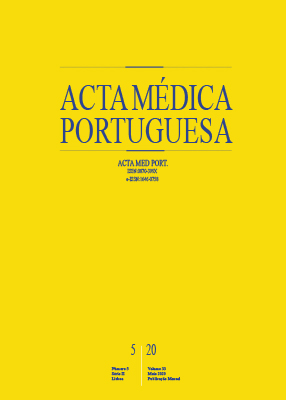Analysis of the Breast Cancer Mortality Rate in Portugal Over a Decade: Spatiotemporal Clustering Analysis
DOI:
https://doi.org/10.20344/amp.11749Keywords:
Breast Neoplasms/mortality, Portugal, Space-Time Clustering, Spatio-Temporal AnalysisAbstract
Introduction: Breast cancer is the first cause of cancer-related death in Portuguese women. This study aimed to characterize female breast cancer mortality in Portugal in the period between 2002 and 2013, with a special focus on spatiotemporal patterns.
Material and Methods: The breast cancer mortality rate was studied using descriptive analysis (unadjusted and age-adjusted), and spatiotemporal clustering analyses.
Results: In 2002 – 2013 the breast cancer mortality rate was 28.47/100 000 inhabitants and the age-adjusted mortality rate was 19.46/100 000 inhabitants. In this period the Lisbon region (urban), Alentejo and Algarve (rural) presented higher breast cancer mortality rate, but Madeira (urban), Lisbon and Algarve had higher age-adjusted mortality rate. In the spatiotemporal analysis, the overall mortality rate showed an increasing trend of 1.218%/year, without spatial variations. Also, different patterns were detected in the < 50, 50 - 64 and ≥ 65 age-groups (+ 0.725%, - 1.781% and + 0.896%, respectively). One temporal (2004 – 2006) and one spatiotemporal cluster (North coast) presented significantly lower mortality rate than expected for the period and/or area (26.2 and 16.1/100 000 inhabitants, respectively). Conversely, two spatiotemporal clusters, located in the city of Lisbon (2002 – 2007) and in the Centre region (2008 – 2013), presented significantly higher breast cancer mortality rate than expected (48.6 and 34.9/100 000 inhabitants, relative risk: 1.74 and 1.26, respectively).
Discussion: The annual female crude and adjusted breast cancer mortality rate matched previous publications. However the annual increase detected in the unadjusted rate clashes with the published literature. Overall, the presence of spatiotemporal clusters supports the uneven distribution of the breast cancer mortality reported previously in the different Portuguese regions.
Conclusion: This study identified areas and trends of the female breast cancer mortality rate, showing high spatiotemporal variations that must support further detailed studies/interventions.
Downloads
Downloads
Published
How to Cite
Issue
Section
License
All the articles published in the AMP are open access and comply with the requirements of funding agencies or academic institutions. The AMP is governed by the terms of the Creative Commons ‘Attribution – Non-Commercial Use - (CC-BY-NC)’ license, regarding the use by third parties.
It is the author’s responsibility to obtain approval for the reproduction of figures, tables, etc. from other publications.
Upon acceptance of an article for publication, the authors will be asked to complete the ICMJE “Copyright Liability and Copyright Sharing Statement “(http://www.actamedicaportuguesa.com/info/AMP-NormasPublicacao.pdf) and the “Declaration of Potential Conflicts of Interest” (http:// www.icmje.org/conflicts-of-interest). An e-mail will be sent to the corresponding author to acknowledge receipt of the manuscript.
After publication, the authors are authorised to make their articles available in repositories of their institutions of origin, as long as they always mention where they were published and according to the Creative Commons license.









